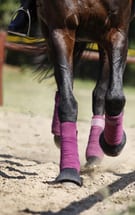Horse Hoof Care
 Taking good care of a horse always involves paying attention to the animal's hooves as well as to its coat, eyes, gait and attitude. A healthy horse should have healthy feet and many medical difficulties can be avoided if the horse's feet and hooves are examined and groomed on a regular basis. This way, a sense of what is normal for the particular animal is established and any indication of a problem can be dealt with promptly.
Taking good care of a horse always involves paying attention to the animal's hooves as well as to its coat, eyes, gait and attitude. A healthy horse should have healthy feet and many medical difficulties can be avoided if the horse's feet and hooves are examined and groomed on a regular basis. This way, a sense of what is normal for the particular animal is established and any indication of a problem can be dealt with promptly.
Regular Grooming of the Hooves
Regular hoof grooming involves both checking general hoof condition and picking out the horse's feet.
Checking General Hoof Condition
One sign of a healthy horse is the temperature of the foot. Under optimal conditions, the foot should feel slightly warm. The triangular portion of the hoof, known as the frog, should feel firm but slightly pliable. Peeling of this region is no cause for alarm since a healthy horse sheds the frog at least semi-annually. If the horse is shod, its shoes should be examined as well as his hooves to make sure they offer protection and stability.
Picking Out
Picking out the horse's hooves is a daily necessity. This process includes the following steps:
- Each morning, check the horse's pulse and body temperature (by touch)
- Before turning the horse out, remove any manure in the stall or paddock
- Check the animal for any signs of thrush
- Before riding, remove any small stones or other objects
- Afterwards, remove any debris that accumulated during the ride
- Check for turnout injuries or objects before the horse beds down
Every time the horse's hooves are examined, any remaining matter should be removed from the frog or the sole with the tip of the pick. As a final step, a stiff brush should be used to complete the grooming.
Farrier Visits
Farrier visits are normally scheduled every 6 to 8 weeks for trimming and shoeing the horse. Between visits, the animal should be regularly checked for signs that the shoe is lifting (risen clinches) or sprung (pulled away or bent). Either of these conditions warrant immediate attention because they may be causing pain or damage to the hoof.
It is very helpful to have the farrier demonstrate how to remove a shoe that is shifted or sprung. This will make possible emergency intervention before farrier visits and prevent unnecessary suffering.
Signs of Trouble
 Regular hoof grooming will keep the horse more comfortable in the present and healthier in the future. Problems to be on the lookout for include:
Regular hoof grooming will keep the horse more comfortable in the present and healthier in the future. Problems to be on the lookout for include:
- Thrush, a bacterial infection in the frog
- Puncture wounds
- Cracks
- Abscesses
If any of these conditions is evident, the farrier, and sometimes the veterinarian, should be consulted to determine whether the horse requires immediate attention. It is always best to err on the side of caution since puncture wounds are very dangerous and abscesses are often a sign of laminitis, an inflammation that can result in severe hoof damage.
Other Steps to Hoof Health
In order to assist the horse in growing the healthiest hooves possible, the veterinarian should be consulted about how best to meet the individual animal's nutritional needs. Regular exercise is necessary to keep the horse's circulation, in the hooves and elsewhere, strong enough to promote growth. Horses should be kept out of deep mud whenever possible since the suction of the mud can pull off shoes and may encourage skin infections or thrush.
Horse that are used for hauling should have their hooves bandaged or wear bell boots or shipping boots to protect its heels.
